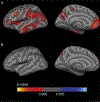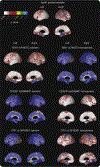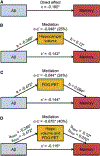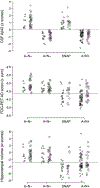Recent publications from the Alzheimer's Disease Neuroimaging Initiative: Reviewing progress toward improved AD clinical trials
- PMID: 28342697
- PMCID: PMC6818723
- DOI: 10.1016/j.jalz.2016.11.007
Recent publications from the Alzheimer's Disease Neuroimaging Initiative: Reviewing progress toward improved AD clinical trials
Abstract
Introduction: The Alzheimer's Disease Neuroimaging Initiative (ADNI) has continued development and standardization of methodologies for biomarkers and has provided an increased depth and breadth of data available to qualified researchers. This review summarizes the over 400 publications using ADNI data during 2014 and 2015.
Methods: We used standard searches to find publications using ADNI data.
Results: (1) Structural and functional changes, including subtle changes to hippocampal shape and texture, atrophy in areas outside of hippocampus, and disruption to functional networks, are detectable in presymptomatic subjects before hippocampal atrophy; (2) In subjects with abnormal β-amyloid deposition (Aβ+), biomarkers become abnormal in the order predicted by the amyloid cascade hypothesis; (3) Cognitive decline is more closely linked to tau than Aβ deposition; (4) Cerebrovascular risk factors may interact with Aβ to increase white-matter (WM) abnormalities which may accelerate Alzheimer's disease (AD) progression in conjunction with tau abnormalities; (5) Different patterns of atrophy are associated with impairment of memory and executive function and may underlie psychiatric symptoms; (6) Structural, functional, and metabolic network connectivities are disrupted as AD progresses. Models of prion-like spreading of Aβ pathology along WM tracts predict known patterns of cortical Aβ deposition and declines in glucose metabolism; (7) New AD risk and protective gene loci have been identified using biologically informed approaches; (8) Cognitively normal and mild cognitive impairment (MCI) subjects are heterogeneous and include groups typified not only by "classic" AD pathology but also by normal biomarkers, accelerated decline, and suspected non-Alzheimer's pathology; (9) Selection of subjects at risk of imminent decline on the basis of one or more pathologies improves the power of clinical trials; (10) Sensitivity of cognitive outcome measures to early changes in cognition has been improved and surrogate outcome measures using longitudinal structural magnetic resonance imaging may further reduce clinical trial cost and duration; (11) Advances in machine learning techniques such as neural networks have improved diagnostic and prognostic accuracy especially in challenges involving MCI subjects; and (12) Network connectivity measures and genetic variants show promise in multimodal classification and some classifiers using single modalities are rivaling multimodal classifiers.
Discussion: Taken together, these studies fundamentally deepen our understanding of AD progression and its underlying genetic basis, which in turn informs and improves clinical trial design.
Keywords: Alzheimer's disease; Amyloid; Biomarker; Disease progression; Mild cognitive impairment; Tau.
Copyright © 2017. Published by Elsevier Inc.
Figures












































References
-
- Liu E, Luthman J, Cedarbaum JM, Schmidt ME, Cole PE, Hendrix J, et al. Perspective: The Alzheimer’s Disease Neuroimaging Initiative and the role and contributions of the Private Partner Scientific Board (PPSB). Alzheimers Dement 2015;11:840–9. - PubMed
-
- Anderson DC, Kodukula K. Biomarkers in pharmacology and drug discovery. Biochem Pharmacol 2014;87:172–88. - PubMed
Publication types
MeSH terms
Grants and funding
- P30 AG043097/AG/NIA NIH HHS/United States
- U01 AG032438/AG/NIA NIH HHS/United States
- U54 EB020406/EB/NIBIB NIH HHS/United States
- P30 AG010133/AG/NIA NIH HHS/United States
- R01 NS092625/NS/NINDS NIH HHS/United States
- P50 NS053488/NS/NINDS NIH HHS/United States
- U19 HD077671/HD/NICHD NIH HHS/United States
- R01 AG043392/AG/NIA NIH HHS/United States
- R01 NS089757/NS/NINDS NIH HHS/United States
- R01 AG047827/AG/NIA NIH HHS/United States
- U01 HG008685/HG/NHGRI NIH HHS/United States
- R01 AG049704/AG/NIA NIH HHS/United States
- R01 CA199668/CA/NCI NIH HHS/United States
- U01 AG042791/AG/NIA NIH HHS/United States
- P41 EB015922/EB/NIBIB NIH HHS/United States
- R01 AG046171/AG/NIA NIH HHS/United States
- R01 CA115483/CA/NCI NIH HHS/United States
- P30 CA093373/CA/NCI NIH HHS/United States
- R01 AG041851/AG/NIA NIH HHS/United States
- P30 AG010124/AG/NIA NIH HHS/United States
- RF1 AG047866/AG/NIA NIH HHS/United States
- R01 AG019771/AG/NIA NIH HHS/United States
- P50 AG016574/AG/NIA NIH HHS/United States
- R44 AG049540/AG/NIA NIH HHS/United States
- U01 AG024904/AG/NIA NIH HHS/United States
- U19 AG010483/AG/NIA NIH HHS/United States
- U41 HG006834/HG/NHGRI NIH HHS/United States
- U54 NS100064/NS/NINDS NIH HHS/United States
- P01 AG003991/AG/NIA NIH HHS/United States
- P50 AG005681/AG/NIA NIH HHS/United States
- R01 CA199725/CA/NCI NIH HHS/United States
- R01 MH098260/MH/NIMH NIH HHS/United States
- U54 HD079125/HD/NICHD NIH HHS/United States
- R01 AG048252/AG/NIA NIH HHS/United States
- R01 AG011378/AG/NIA NIH HHS/United States
- R01 AG037551/AG/NIA NIH HHS/United States
- R01 LM011360/LM/NLM NIH HHS/United States
- R01 CA129769/CA/NCI NIH HHS/United States
- U01 AG010483/AG/NIA NIH HHS/United States
- U01 HG006500/HG/NHGRI NIH HHS/United States
- UF1 AG032438/AG/NIA NIH HHS/United States
- R01 HG005092/HG/NHGRI NIH HHS/United States
- U54 NS079202/NS/NINDS NIH HHS/United States
- R01 CA159447/CA/NCI NIH HHS/United States
- P30 AG010129/AG/NIA NIH HHS/United States
- U01 AG006786/AG/NIA NIH HHS/United States
- U19 AG032438/AG/NIA NIH HHS/United States
LinkOut - more resources
Full Text Sources
Other Literature Sources
Medical

